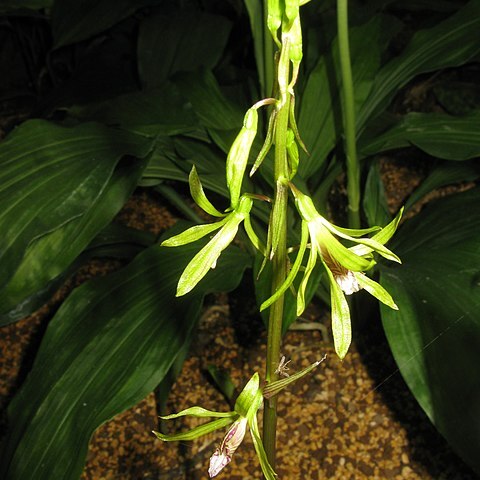Terrestrial herbs arising from small tubers. Tubers ovoid or ellipsoid, ± dorsiventrally flattened, ± pubescent. Hysterantherous, with the leaf appearing after the flowering stem has withered. Leaf erect, suberect or prostrate, solitary, lanceolate, ovate, cordate or reniform, glabrous or pubescent; petiole short or long, often sulcate, subtended at the base by a sheathing, acute or obtuse cataphyll. Inflorescence erect, 1–many-flowered, racemose. Scape bearing 3–4 ± sheathing cataphylls, ± elongating after fertilisation. Flowers erect, horizontal or pendent (mostly pendent when fertilised), green, yellow, brown, white, pink or purple; bracts lanceolate, very acute; pedicel thin, ridged; ovary ellipsoidal, 3-or 6-ridged. Sepals and petals subsimilar, lanceolate. Lip entire or trilobed, ± papillate or pubescent, sometimes spurred. Column ± clavate; anther terminal, conical to oblong; pollinia 2, granular; stigma ventral, orbicular to triangular, towards apex of column, separated from anther by a broad blunt rostellum.
Terrestrial tuberous orchids. Flowering and non-flowering plants dimorphic, growing in vegetative colonies. Rootstock consists of stem tubers with nodes and short, spreading roots, reproducing by daughter stem tubers produced on the end of horizontal, multi-noded stolons. Sterile plants consist of a single, plicate, ground-hugging or erect leaf. Flowering plants have no leaf at flowering time, but consist of a fleshy flower stem with 1 to a few erect or nodding flowers, leaf arising at the base of the finished flower stem. Inflorescence racemose, 1-to few-flowered. Flowers resupinate or non-resupinate, short-lived (1–4 days). Sepals and petals free, narrow, similar in size and shape. Labellum attached to anterior base of column. Labellum lamina 3-lobed, without spur; lateral lobes column-embracing. Column slender, without basal foot.
Flowers resupinate or (in some 1-flowered species) erect; tepals except the lip similar, green or brownish-green; lip spurless or shortly spurred, 3-lobed to almost entire, often more or less papillate or pubescent and variously marked with red; column long, curved or almost straight, more or less slender towards the base; clinandrium a deep apical cavity embracing a large part of the anther; stigma ventral, elliptic to almost square, viscidium diffuse; anther incumbent, hinged; pollinia 2, bipartite, sectile.
Terrestrial tuberous herb in which the leaves are produced after the flowers (hysteranthous); tubers subterranean subspherical, rhizomatouswith 2–7 internodes, bearing short straight roots andashort ascending stem 1–15 cm long.
Foliar leaf solitary, erect or prostrate, plicate, non-articulate, elliptic to reniform or almost circular, the upper surface sometimes pubescent and/or with various silvery patterns, the lower surface often purple.
Inflorescence erect, 1–many-flowered, racemose; scape 2–60 cm long.

